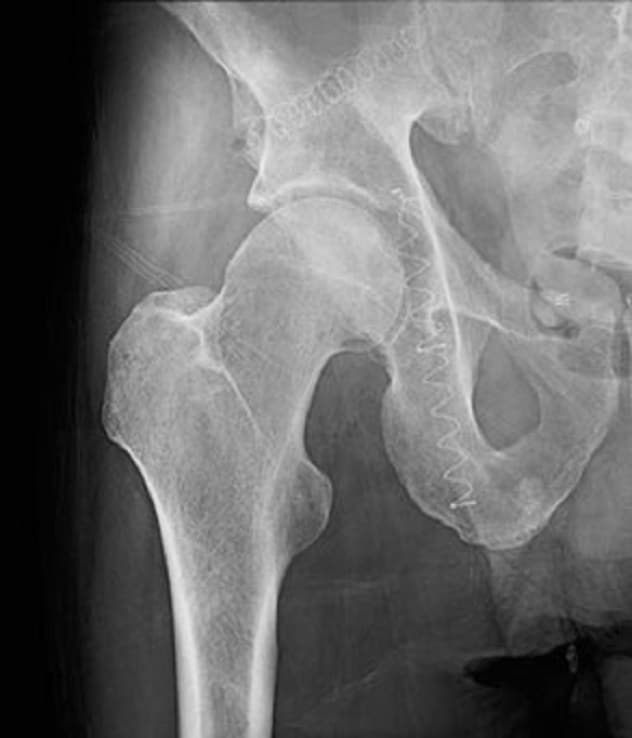Sept. 24, 2024
 Metastatic pelvic tumors
Metastatic pelvic tumors
A pelvis with a lesion
Mayo Clinic in Arizona is now one of the few U.S. medical centers offering minimally invasive pelvic fixation for metastatic disease, a procedure commonly used for patients with advanced breast, lung or prostate cancer or advanced melanoma. Meagan E. Tibbo, M.D., M.S., an orthopedic surgeon at Mayo Clinic in Arizona, is leading an effort to address these metastases before they cause pelvic fractures.
How did you become interested in metastatic pelvic tumors?
Metastatic disease is increasing rapidly and has become quite common in our practice. Chemotherapy and radiation are keeping people alive longer, so they have more time for metastases to develop.
My treatment goal for patients with metastatic pelvic tumors is to get them back to pain-free walking or to help them walk and get back to chemotherapy quickly.
Why are pelvic fixation systems needed?
When these metastases are present in the bone, they affect the bone's structural integrity and cause pain. Both issues compromise patient mobility and place patients at risk of pelvic fracture.
When patients experience pain during weight bearing, their bodies are telling them their bones could break. I advise patients that a bone doesn't hurt unless something is wrong. At this point, most patients seek medical attention, often an emergency hospital consult. They often mention hip pain, yet their physicians determine that the pain is not arthritic and find bone metastasis.
How is pelvic metastasis identified, and what are the demographics for patients who require fixation?
If the metastasis is structural, the resulting pain helps identify it quickly. If it is not structural, it takes longer to identify.
Demographics beyond tumor type are variable. The patients may be women in their forties or men in their nineties. Anyone over age 35 might have pelvic metastases. It's rare in children.
How do you determine patients' prognoses to know if fixation is appropriate?
It's challenging to judge for certain how long a patient might live, despite data we have for similar patients. We make an educated survival estimate with the help of our colleagues in medical oncology. Once we have that estimate, we make a shared decision with the patient about whether to proceed with surgery. Typically, if the estimated survival is greater than three months, we offer surgical intervention.
How is pelvic fixation performed?
Percutaneous pelvic fixation's intent is to provide structural support. While the patient is under general anesthesia, I make three incisions; each is approximately 1 centimeter.
Next, I perform percutaneous radiofrequency ablation of the lesion itself, if possible. Thereafter, the balloons are inserted, filled with cement and cured with a light. The goal of balloon placement is to restore the three structural columns of the pelvis. The procedure is performed using simultaneous CT navigation and fluoroscopy to confirm that the balloons are in the correct location.
"Longer term, patients regain pain-free walking or even the ability to walk at all. When it works, it's fantastic."
What is recovery like after pelvic fixation?
Often, patients feel a lot better postoperatively. The incisional pain is minimal. My goal is for patients to walk on the same day as surgery. Longer term, patients regain pain-free walking or even the ability to walk at all. When it works, it's fantastic.
Many patients have radiation therapy after pelvic fixation to treat microscopic disease after an intralesional procedure.
Does timing matter for pelvic fixation?
Yes. The metastases often grow, increasing fracture risk. Tumors can grow large in the pelvis due to available space. Surgery prior to fracture is less invasive. Once the pelvis has broken, surgery is typically much more challenging and invasive, requiring more time off chemotherapy.
It's also important for patients to have medical attention rapidly, as immobility has not only significant emotional consequences but also medical consequences.
Which patients are ineligible for pelvic fixation?
While many patients with pelvic metastases are eligible for fixation, some are not due to:
- Frailty. Patients with metastatic cancer may not be physically resilient enough to withstand pelvic fixation or other surgery.
- Extent of disease. This type of percutaneous fixation requires a certain amount of intact bone to function effectively.
If a patient needs treatment beyond pelvic fixation, chemotherapy and radiation therapy, what's available?
Other treatment options may include:
- Complex hip replacement. This is an invasive treatment for metastases requiring patients to pause systemic therapy for 4 to 6 weeks.
- Resection arthroplasty. This procedure is a last-resort pain relief and infection-reduction measure involving femoral head resection. Patients can mobilize postoperatively, but they limp and must learn a new gait due to the changed anatomy.
Why should I consider referring a patient to Mayo Clinic for pelvic fixation?
Mayo Clinic's organization facilitates pelvic fixation. This is due to its ability to coordinate all the necessary logistics and communication between medical and surgical professionals, such as discussing when to stop the patient's chemotherapy to perform the fixation. The clinic also has specialists with significant experience with the pelvis, which is a high-risk, anatomically complex region.
For more information
Refer a patient to Mayo Clinic.